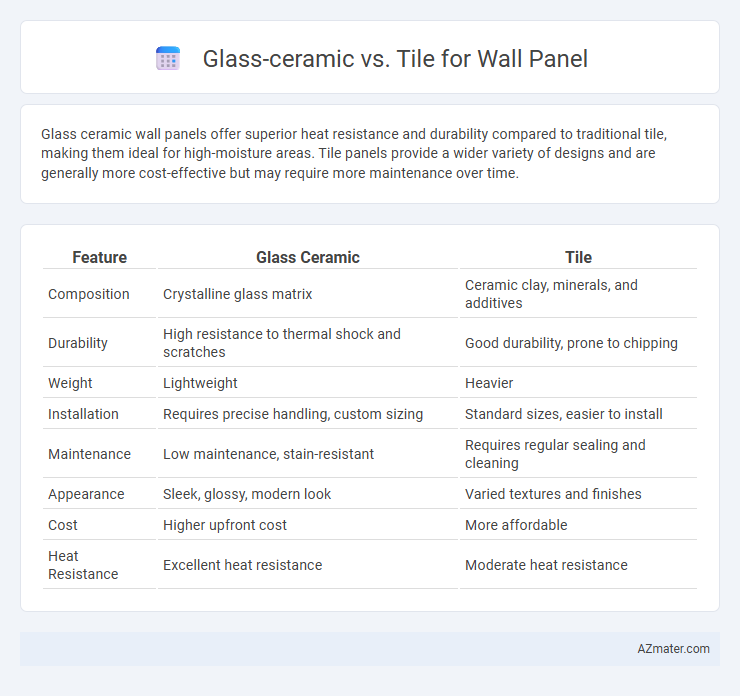Glass ceramic wall panels offer superior heat resistance and durability compared to traditional tile, making them ideal for high-moisture areas. Tile panels provide a wider variety of designs and are generally more cost-effective but may require more maintenance over time.
Table of Comparison
| Feature | Glass Ceramic | Tile |
|---|---|---|
| Composition | Crystalline glass matrix | Ceramic clay, minerals, and additives |
| Durability | High resistance to thermal shock and scratches | Good durability, prone to chipping |
| Weight | Lightweight | Heavier |
| Installation | Requires precise handling, custom sizing | Standard sizes, easier to install |
| Maintenance | Low maintenance, stain-resistant | Requires regular sealing and cleaning |
| Appearance | Sleek, glossy, modern look | Varied textures and finishes |
| Cost | Higher upfront cost | More affordable |
| Heat Resistance | Excellent heat resistance | Moderate heat resistance |
Introduction to Wall Panel Materials
Glass ceramic wall panels offer superior heat resistance, durability, and a sleek, modern aesthetic compared to traditional tile panels, which are known for their affordability and ease of installation. Tile panels, typically made from ceramic or porcelain, provide a wide variety of design options and textures but can be more prone to cracking and grout discoloration over time. Choosing between glass ceramic and tile depends on factors such as desired visual appeal, maintenance requirements, and environmental exposure in interior or exterior applications.
What is Glass Ceramic?
Glass ceramic is a unique material formed by controlled crystallization of glass, combining the aesthetic appeal of glass with the durability and heat resistance of ceramics. It offers a smooth, non-porous surface ideal for wall panels, providing superior stain resistance and easy maintenance compared to traditional tile. Glass ceramic panels also excel in thermal shock resistance and structural strength, making them suitable for modern interior designs requiring both functionality and elegance.
What are Tiles?
Tiles are durable, flat pieces made from ceramic, porcelain, stone, or glass, designed for wall and floor coverings with high resistance to moisture and wear. They come in various sizes, textures, and finishes, offering versatile design options for interior surfaces. Their ease of installation and maintenance makes tiles a popular choice for kitchen backsplashes, bathrooms, and accent wall panels.
Aesthetic Differences
Glass ceramic wall panels offer a sleek, glossy finish that enhances light reflection and creates a modern, sophisticated ambiance. Tile panels provide diverse textures and patterns, allowing for classic, rustic, or intricate design styles with matte, glazed, or textured surfaces. The choice between glass ceramic and tile significantly impacts the visual appeal and atmosphere of interior spaces, with glass ceramic emphasizing minimalism and tile offering versatile aesthetic flexibility.
Durability and Strength Comparison
Glass ceramic wall panels exhibit superior durability due to their resistance to scratches, impact, and thermal shock, making them ideal for high-traffic and moisture-prone areas. Tile wall panels, while strong and widely used, tend to be more susceptible to chipping and grout damage over time, potentially reducing their long-term resilience. The non-porous surface of glass ceramic also prevents staining and water infiltration, enhancing its structural integrity compared to traditional tile materials.
Installation Process and Complexity
Glass ceramic wall panels require precise cutting and professional installation due to their fragility and the need for special adhesives, making the process more complex and time-consuming. Tile installation involves laying individual pieces with grout lines, which is labor-intensive but allows for easier adjustments and repairs during installation. The complexity of glass ceramic installation demands higher skill levels and specialized tools, whereas tile offers more flexibility at the cost of prolonged installation time.
Maintenance and Cleaning Requirements
Glass ceramic wall panels offer low maintenance with non-porous surfaces that resist stains, mold, and mildew, requiring only simple wiping with mild detergents. Tile panels demand more frequent grout cleaning to prevent discoloration and mold buildup, increasing overall upkeep time and effort. The smooth, seamless finish of glass ceramic reduces the accumulation of dirt and grime compared to the grout lines in tile installations.
Cost Analysis
Glass ceramic wall panels generally have a higher upfront cost compared to traditional tile due to advanced manufacturing processes and durability. Installation expenses also tend to be higher for glass ceramic because of the need for specialized adhesives and professional handling to prevent breakage. Over time, glass ceramics offer lower maintenance costs and enhanced longevity, potentially offsetting the initial investment when compared to tile options prone to grout deterioration and frequent repairs.
Environmental Impact
Glass ceramic wall panels offer a lower environmental footprint due to their recyclability and energy-efficient production processes, which reduce greenhouse gas emissions compared to traditional tile manufacturing. Tiles frequently rely on clay extraction and high-temperature kiln firing, leading to significant resource depletion and carbon emissions. Choosing glass ceramic panels supports sustainable building practices by minimizing waste and promoting the use of eco-friendly materials.
Which is Better: Glass Ceramic or Tile for Wall Panels?
Glass ceramic wall panels offer superior durability, heat resistance, and a sleek, modern aesthetic compared to traditional tiles, making them ideal for kitchens and bathrooms. Tiles provide greater variety in texture and design choices but require more maintenance due to grout lines that can collect dirt and moisture. For long-lasting, easy-to-clean wall surfaces with a seamless look, glass ceramic outperforms tile options in both functionality and style.

Infographic: Glass ceramic vs Tile for Wall Panel
 azmater.com
azmater.com